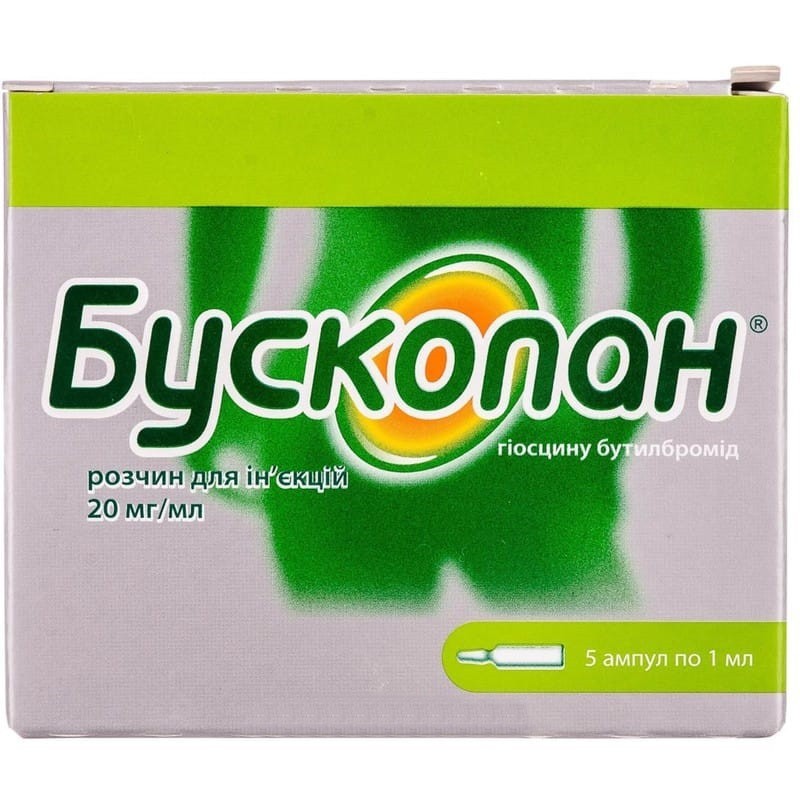



 Secure and encrypted payment processing
Secure and encrypted payment processing We ship to over 40 countries including the USA, UK, Europe, Australia and Japan
We ship to over 40 countries including the USA, UK, Europe, Australia and Japan Guaranteed refund or reship if you haven't received your order
Guaranteed refund or reship if you haven't received your orderHyoscine (scopolamine) butyl bromide is an antispasmodic with the anticholinergic action of a group of quaternary ammonium compounds, which is close to atropine in pharmacological properties. the antispasmodic effect of the drug on smooth muscles of internal organs is associated with blockade of m-cholinergic receptors. in therapeutic doses does not affect the central nervous system, the secretion of salivary and sweat glands, and the ability to accommodate.
Partially absorbed after oral (8%) or rectal (3%) administration; systemic bioavailability is less than 1%. However, despite the low concentration of the drug in the blood, relatively high local concentrations of scopolamine butyl bromide and its metabolites are determined directly at the sites of action - the digestive tract, bile ducts, liver and kidneys. It weakly binds to plasma proteins, does not penetrate the BBB. After iv administration of Buscopan, its plasma concentration rapidly decreases due to the rapid distribution of the drug in the tissues. Distribution volume - 128 l (about 1,7 l / kg). The drug is metabolized mainly in the liver, excreted in the bile and urine, most of it unchanged.
Digestive tract spasms, dyskinesia and spasm of the biliary and urinary tract, including biliary and renal colic attacks, preparation for diagnostic and therapeutic procedures (for parenteral administration).
Adults and schoolchildren are usually prescribed 1–2 tablets inward or 1–2 suppositories (10 mg) rectally 3–5 times a day (suppositories must be administered after bowel movement). children under the age of 1 year - 1 suppository (7.5 mg) 2-3 times a day, older than 1 year - 3-5 times a day.
In acute spastic pain, adults are given the contents of 1-2 ampoules several times a day s / c, i / m or iv; the maximum daily dose is 100 mg. Children - 0.3-0.6 mg / kg body weight several times a day; the maximum daily dose is 1.5 mg / kg body weight.
Children - 0.25 ml of injection solution up to 3 times a day.
Severe pseudoparalytic myasthenia gravis, megacolon, hypersensitivity to the drug; parenterally not prescribed for untreated angle-closure glaucoma, prostate hypertrophy with urinary retention, organic stenosis of the digestive tract.
Xerostomia, dyshidrosis, tachycardia, urinary retention, skin-allergic reactions, shortness of breath, anaphylactic reactions.
Caution should be prescribed for prostate hypertrophy, cardiac arrhythmias and coronary circulation, with intestinal obstruction or impaired urine outflow,
Drivers of vehicles should bear in mind the possibility of impaired accommodation during parenteral administration of the drug.
Clinical studies have not established the presence of embryo- or fetotoxic properties in the drug, but Buscopan should be prescribed with caution, especially in the first trimester of pregnancy. The safety of taking the drug during lactation has not been established.
With simultaneous use, the drug can potentiate the anticholinergic effect of antihistamines, tricyclic antidepressants, quinidine, amantadine, disopyramide. the simultaneous administration of dopamine receptor antagonists can lead to a decrease in the effectiveness of both drugs. with the simultaneous administration of buscopan and b-adrenergic agonists, tachycardia may occur.
Most likely, urinary retention, a feeling of dry mouth, flushing of the skin, tachycardia, inhibition of motility of the digestive tract, temporary visual impairment. with an overdose of the drug in the form of tablets, gastric lavage is carried out, magnesium sulfate and activated carbon are prescribed inside. glaucoma patients are prescribed pilocarpine locally. if necessary, parasympathomimetics are prescribed, for example, neostigmine at a dose of 0.5–2.5 mg IM or IV. conduct symptomatic and supportive therapy (treatment of complications from the cardiovascular system, according to indications - intubation and mechanical ventilation, catheterization of the bladder).